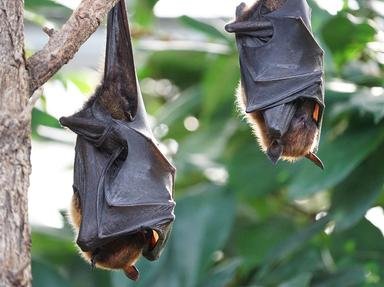Quiz Answer Key and Fun Facts
1. Bats eat various types of food. Some species are insectivores, while others are nectarivores, going to flowers and sipping on their nectar. What kind of bat is shown in the photo here?
2. It is present in bats, but also in birds, gliding mammals, and flying lizards. What is the name of the membranous body part that runs between a bat's digits and assists it in flying?
3. While it is well-known that many bats use echolocation to find food, not all of them do. Which group of bats (with a few exceptions) does NOT echolocate, instead relying on their senses of sight and smell to feed?
4. Bat guano is an incredible fertilizer, and the guano of insectivorous species of bats is particularly beneficial to fungi populations. Present in insect exoskeletons, what compound in the guano makes this true?
5. Vampire bats are able to find the blood vessels of the animals they feed on by sensing infrared radiation.
6. Weighing in at only two grams, Kitti's hog-nosed bat is the world's smallest bat. What other name is given to this bat?
7. Which of the following does NOT contribute to bats' ability to hang upside down while they roost?
8. Some bats, such as the little broad-nosed bat in Australia, need to protect themselves from the extreme temperatures and aridness of summer. Sometimes called the opposite of hibernation, what process do they undergo?
9. Because of their physiology and social natures, bats are a natural reservoir of which of the following infectious diseases pictured here?
10. What happened to the Christmas Island pipistrelle, a species of vesper bat, in 2009?
Source: Author
trident
This quiz was reviewed by FunTrivia editor
rossian before going online.
Any errors found in FunTrivia content are routinely corrected through our feedback system.
